Are you looking for fresh dinner ideas to liven up your evenings? Explore our quick and easy dinner recipes, perfect for busy weeknights. From comforting one-pot meals to healthy family dinners, we’ve got options for Sunday dinner ideas. Dive into vegetarian and vegan dinner recipes. Discover kid-friendly recipes that will delight the little ones, and cheap dinners for a family to keep your expenses in check. So, you must try these budget-friendly meal ideas.
Are you tired of eating the same meals every week?
Do you want to switch up your dinner plans and try something new?
One way to add variety to your meals is by incorporating seasonal ingredients.
Not only will this add a new dimension of flavor to your dishes, but it will also be more cost-effective and environmentally sustainable.
In this article, we’ll explore different ways to incorporate seasonal ingredients into your dinner plans.

Quick Easy Dinner Ideas For Family Tonight
“ Affiliate links are provided for your convenience, please read my disclosure for more information.”
25. Hibachi Chicken With Fried Rice & Vegetables
Craving the Japanese steakhouse experience? This Hibachi Chicken Dinner brings it right to your kitchen!
It’s got everything: tender chicken, restaurant-style sautéed veggies, and savory fried rice—all served with a spicy mustard dipping sauce for that classic hibachi taste.
Perfect for a fun dinner with family, this dish feels just as exciting as going out.
With this easy, flavorful recipe, you can skip the restaurant reservations and enjoy a tasty dinner for two or the whole family at home.
Gather around and dig in—this meal’s a guaranteed hit for a cozy night in!

24. Chicken Broccoli Alfredo
Need a quick, satisfying meal? This Chicken Broccoli Alfredo hits all the right notes.
Creamy, comforting, and packed with flavor, it’s made in one pot, so you get everything—aldente pasta, tender chicken, and perfectly cooked broccoli—without extra dishes.
This is one of those easy pasta dishes that feels fancy but is simple to whip up, even on busy weeknights.
Ideal for a cozy dinner with family, this creamy Alfredo is bound to become a go-to in your rotation.
Say goodbye to takeout and hello to homemade comfort food!

23. One Pot Cajun Chicken Pasta
For a meal with a bit of kick, try this One Pot Cajun Chicken Pasta.
Imagine juicy chicken, pasta, and fresh veggies swirled in a creamy, cajun-spiced sauce—it’s a one-pot wonder!
Great for when you need easy pasta dishes that are big on flavor but low on hassle.
This dish comes together fast, perfect for dinner with family or a casual dinner for two.
Whether feeding a crowd or just craving leftovers, this Cajun pasta is a dinner that everyone will love.
Grab your skillet and enjoy a flavor-packed meal!

22. Loaded Chicken & Potato Casserole
If you love one-pot meals that pack a punch without too much sauce, this One-Pot Chicken with Veggies is for you!
With juicy chicken, perfectly cooked pasta and veggies, it’s a quick dinner with family that’s light yet incredibly satisfying.
This dish is ideal for picky eaters and those who love flavor without fuss.
Simple enough for a weekday meal, this one-pot wonder is also an excellent choice for easy food to make at home.
No mush, no mess—just delicious bites every time!

21. Lemon Garlic Butter Chicken & Green Beans Skillet
This Lemon Garlic Butter Chicken is the ultimate one-skillet recipe!
Cooked alongside green beans in a zesty lemon garlic butter sauce, it’s a delicious twist on good chicken thigh recipes that don’t compromise on taste.
Perfect for lovers of healthy balanced meals, it’s a simple chicken thigh bone in recipe that’s comforting yet fresh.
Serve it with a side of rice, or keep it low-carb; either way, it’s bound to become a weeknight favorite. Simple, tasty, and done in one pan!
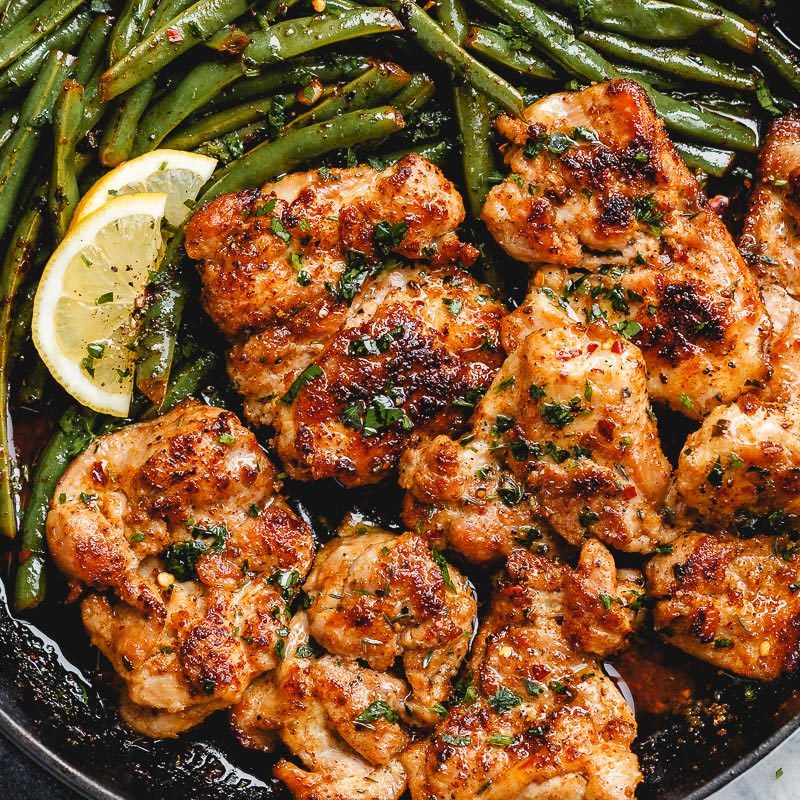
20. Creamy Broccoli Pasta
This Creamy Broccoli Pasta is pure comfort in a bowl! Picture pasta shells generously coated in a buttery Garlic Parmesan Sauce with tender broccoli and a sprinkle of fresh herbs.
A hint of lemon juice at the end brings a zesty touch, making it one of those easy pasta dishes your whole family will love.
It’s ideal for a cozy dinner with family or even a vegetarian main dish on busy nights.
Rich, creamy, and packed with flavor, this pasta recipe is as satisfying as it is simple.

19. Marry Me Chicken
This Marry Me Chicken lives up to its name! Tender chicken breasts are paired with a rich, creamy parmesan sauce, sun-dried tomatoes, and fresh basil for an incredible main course.
Whether you’re cooking for a birthday supper or a romantic dinner for two, this dish delivers flavor with every bite.
It’s a standout among good chicken recipes and one that will keep everyone coming back for more.
Make it once, and you’ll see why it’s a crowd-pleaser!

18. One Pot Chicken & Vegetables Skillet
For an easy, flavorful meal, this One Pot Chicken and Vegetables recipe is a win!
With juicy chicken breast and fresh veggies, this dish cooks up in just 20 minutes.
Great for meal prep or as a quick dinner with family, this recipe is all about minimal effort and maximum taste.
It’s also a fantastic option for those seeking healthy balanced meals that fit seamlessly into a busy schedule.
Give it a try, and enjoy easy home-cooked goodness with no extra fuss!
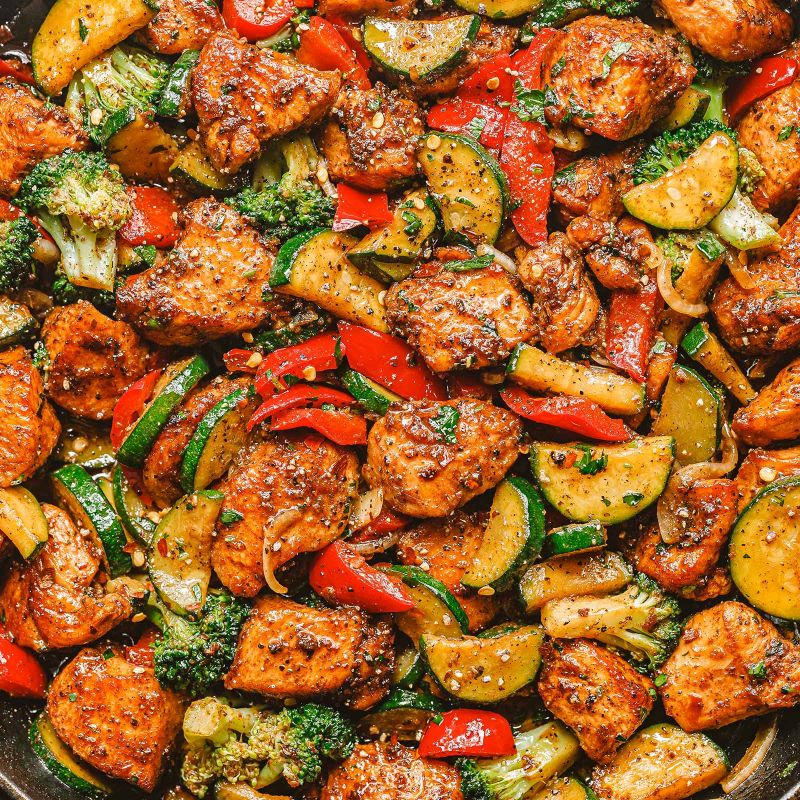
17. Juicy Oven Baked Chicken Breast
For a go-to baked chicken, this Oven Baked Chicken Breast recipe can’t be beaten!
With just 5 minutes of prep, this simple chicken breast recipe turns basic ingredients into a mouth-watering main course.
Perfect for meal prep or an easy dinner, this dish fits into any meal plan and always delivers on flavor.
Try it as a quick addition to healthy dinner options or enjoy it as a main with your favorite sides. It’s a true kitchen essential!
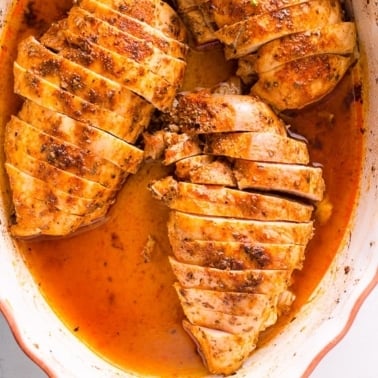
16. Honey Garlic Shrimp
This Honey Garlic Shrimp recipe is as quick as it is delicious!
Ready in 10 minutes, this easy weeknight dinner recipe features tender shrimp coated in a sweet, sticky honey garlic sauce that’s addictive.
Pair it with rice, salad, or steamed veggies for a balanced meal that doesn’t skimp on flavor.
This is one of those shrimp dishes with rice that feels special but takes almost no time, making it perfect for busy nights or last-minute dinners.
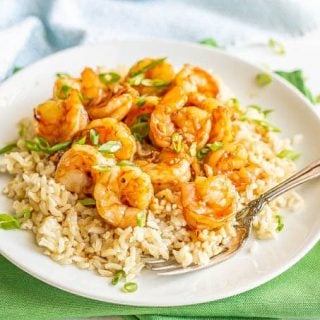
15. Hot Honey Chicken Bowls
Spicy, savory, and slightly sweet, these Hot Honey Chicken Bowls pack a flavor punch!
Perfect for a dinner with family or as part of healthy balanced meals, this dish is a winner for those who love bold flavors.
Serve it over rice or a fresh salad for a meal that feels like a treat yet fits easily into your routine.
Ideal for weeknight dinners, these bowls bring variety and taste to your menu with minimal effort.

14. Smothered Chicken
This Smothered Chicken brings the flavors of a restaurant-worthy meal right to your kitchen.
With juicy fried chicken breasts, crispy bacon, and a rich, savory gravy, it’s hard to believe this meal is homemade!
Pair it with mashed potatoes or fresh veggies for a dish that delivers on taste and texture.
Perfect for cozy nights at home, this meal is everything you want when craving comfort food with a bit of flair.

13. Cilantro Lime Chicken Thighs
If you’re after a vibrant chicken dish, this Cilantro Lime Chicken is your answer!
Marinated in a bold cilantro-lime blend, the chicken comes out tender and juicy.
Great for dinner options like salads, rice bowls, or tacos, this recipe brings a fresh twist to good chicken thigh recipes.
It’s a perfect choice for anyone looking for light yet flavorful healthy balanced meals that don’t sacrifice taste.
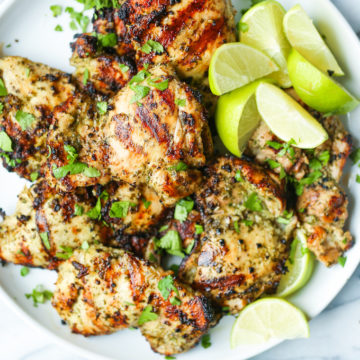
12. Slow Cooker Chicken Burrito Bowl
This Mexican Slow Cooker Chicken Bowl is the epitome of a delicious crockpot meal!
With rice, black beans, corn, avocado, and creamy cilantro lime dressing, it’s an ideal meal prep option for busy weeks.
Perfect for those who love Mexican food recipes with chicken, this bowl has all the bold flavors without the extra work.
Just set it, forget it, and enjoy a meal that feels homemade and hearty.

11. BBQ Pineapple Chicken Kabobs
Craving something sweet and savory? Sweet and Sticky Pineapple Chicken is the perfect blend!
With juicy chicken, fresh pineapple chunks, and colorful peppers, this dish delivers a tropical vibe in every bite.
This easy cooking recipe is great for a fun dinner with family or a relaxed dinner for two.
With a finger-licking sticky sauce, it’s a meal that’ll make you feel like you’re on a mini vacation!
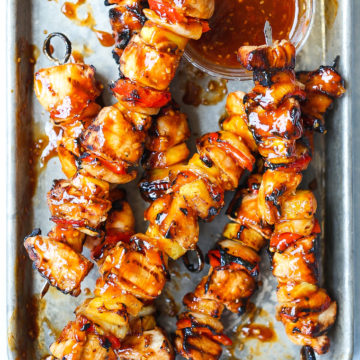
10. Air Fryer Fish Tacos + Cilantro Lime Slaw
These Air Fryer Fish Tacos are your new go-to for busy nights!
Ready in about 15 minutes, these tacos pair perfectly with a Cilantro Lime Slaw for that fresh, tangy twist.
Use your favorite white fish—tilapia, mahi mahi, or cod—for a dinner with a family that’s simple, delicious, and fun to assemble.
This recipe makes a fantastic healthy fish recipe option that brings bold flavors to your plate with minimal effort.
Tacos on a weeknight? Absolutely!

9. Lasagna Roll-Ups
Love lasagna but are short on time? These Lasagna Roll-Ups combine lasagna noodles, ground beef, marinara, and two kinds of cheese into a dish that’s freezer-friendly and perfect for meal prep.
It’s one of those pasta recipes with ground beef that you can make ahead and enjoy anytime.
For family dinners or gatherings, these roll-ups are a time-saving twist on a classic that still delivers that beloved lasagna flavor—without the long cooking time!

8. Mexican Street Tacos
Carne Asada Street Tacos are as easy as they are delicious!
Made with marinated beef, onions, cilantro, and fresh lime juice, these tacos bring authentic Mexican flavors right to your kitchen.
Ideal for those who love Mexican food recipes with beef, this recipe is quick to assemble and perfect for casual gatherings or even a dinner for two.
With just a handful of fresh ingredients, you can savor that street taco experience at home!

7. Chicken Parmesan Casserole
Our Chicken Parmesan Casserole combines crispy chicken, pasta, and layers of mozzarella and parmesan cheese for a warm, comforting meal.
Made with leftover rotisserie chicken or frozen chicken tenders, this casserole is quick to assemble and brings all the flavors of classic Italian recipes to your dinner table.
Perfect for a family-friendly dish or meal prep that freezes well, this casserole is a delicious way to enjoy Italian-inspired comfort food without fuss.

6. Taco Fiesta Bubble Up Casserole
This Taco Fiesta Bubble-Up Casserole is packed with all the taco flavors you love, baked into a family-sized dish that’s easy to serve.
With ground beef, cheese, and a little spice, it’s a festive dish ideal for a birthday supper or dinner with family.
It’s one of those easy family recipes that’s a total crowd-pleaser, perfect for game nights or a relaxed weekend meal.
Simple ingredients, amazing taste, and a guaranteed hit with everyone!
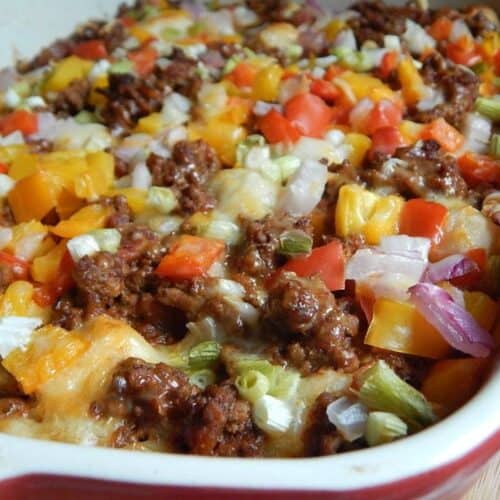
5. Honey Garlic Asian Chicken Kabobs
Transform your grill game with this Honey Garlic Marinade!
With a sweet and savory blend, it’s the perfect Asian chicken dish to marinate overnight and toss on the grill.
Ideal for healthy chicken recipes for weight loss or as a delicious addition to a summer cookout, this marinade brings out the best flavors in your chicken, beef, or even shrimp.
A few ingredients and a lot of flavor—this marinade will be your new grilling favorite!

4. BBQ Chicken Grilled Cheese
BBQ Chicken Grilled Cheese Sandwiches are the perfect comfort food!
French bread, garlicky butter, savory BBQ chicken, and creamy Havarti cheese combine for a unique twist on a classic.
Serve them as dinner for two or add them to a casual family meal.
These sandwiches are great for those who love creative, easy dinner options that still pack tons of flavor.
It’s grilled cheese, elevated—BBQ-style!
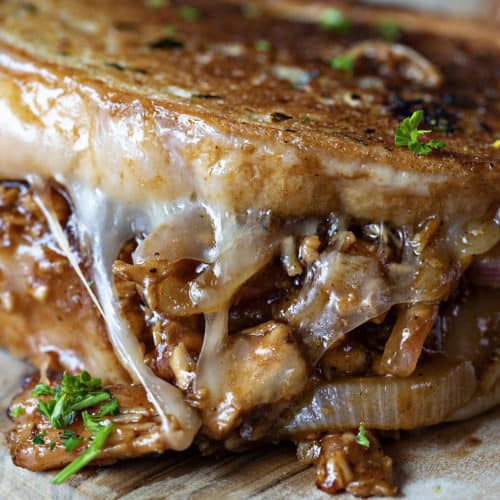
3. Garlic Butter Chicken
This Garlic Butter Chicken is perfect for those nights when you need something simple yet satisfying.
Tender chicken in a rich garlic butter sauce with a splash of wine makes for a dinner with a family that everyone will love.
Ready in just 15 minutes, it’s one of those easy chicken dishes that feels fancy but is effortless.
Serve with rice, pasta, or a fresh salad, and you’ve got a meal that’s as tasty as it is easy.
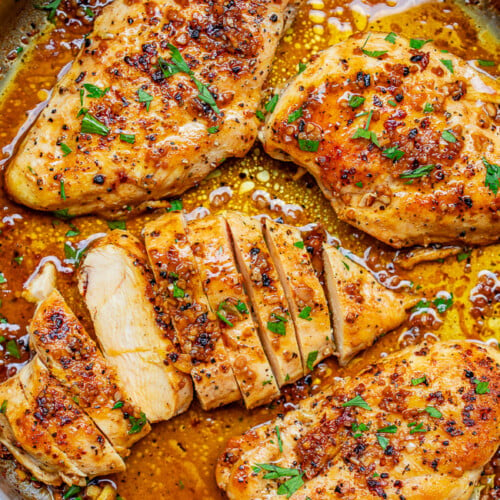
2. Southwest Chicken Wrap
Looking for a quick, tasty meal? This Southwest Chicken Wrap is a winner!
With crispy chicken, fresh veggies, black beans, and a creamy southwest dressing, it’s ideal for lunch or family dinners on the go.
In just 25 minutes, you’ll have a wrap that’s packed with flavor and texture.
Great for busy families, this recipe is sure to be a repeat in your weekly meal rotation for a healthy balanced meal with a southwest kick.

1. Hibachi Chicken + Fried Rice & Vegetables
Bring the restaurant to your kitchen with this Hibachi Chicken Dinner!
With sautéed veggies, fried rice, and tender chicken, it’s all served with a spicy mustard dipping sauce for that authentic hibachi experience.
This meal is an ideal Asian chicken dish for a fun dinner with family or even a special dinner for two.
Packed with flavor and incredibly satisfying, this dish will transport your taste buds right to the Japanese steakhouse—no reservations required!

FAQs
What’s the best recipe for chicken thighs?
One of the best chicken thigh recipes is Cilantro Lime Chicken, which features a zesty marinade that keeps the thighs juicy and flavorful. You can also try a One Pot Chicken and Vegetables recipe, where chicken thighs cook alongside veggies in a rich, savory sauce.
Are there healthy chicken recipes for weight loss?
Absolutely! Honey Garlic Marinade on grilled chicken offers a balanced mix of sweetness and flavor while being low-calorie. Another great option is Garlic Butter Chicken, made without heavy breading and featuring a lighter, flavorful sauce. These recipes are perfect for anyone following a weight-loss plan.
How can I make baked chicken tenders crispy?
To make baked chicken tender recipes crispy, coat the tenders with a light layer of breadcrumbs and spray with a little cooking oil before baking. Using a high oven temperature (around 400°F) will help them crisp up nicely, making them perfect for dipping or adding to wraps and salads.
What’s a quick, easy mac and cheese recipe?
For a quick mac and cheese, boil your pasta, then stir in shredded cheese, a bit of butter, and milk until creamy. Season with salt and pepper for extra flavor. If you want to elevate it, add a sprinkle of garlic powder or mix in cooked ground beef for a complete meal.
How can I make easy family dinner recipes?
For an easy family dinner, consider dishes like BBQ Chicken Grilled Cheese Sandwiches or a Chicken Parmesan Casserole that everyone will enjoy. These recipes come together quickly, pack tons of flavor, and often use ingredients you already have at home. Perfect for busy nights!
Are there healthy fish recipes that are easy to make?
Yes! Air Fryer Fish Tacos are an excellent choice for a healthy, quick meal. Simply cook white fish in the air fryer, add a refreshing Cilantro Lime Slaw, and you’ve got a light, tasty dinner. Another option is baked salmon or cod with a side of roasted vegetables for a low-calorie, nutritious dinner.
What are some good meals to cook for winter?
During winter, comfort meals are key. Lasagna Roll-Ups and Oven Baked Chicken Breast are cozy options that feel hearty and satisfying. You can also try a Beef Chuck Roast in the slow cooker for a warm, flavorful meal that fills the house with inviting aromas.
Now comes the important question… Which dinner ideas do you like the most? Please let me know in the comments.
Few more recipes!!!
Want to save this for later? Post these Dinner Ideas to the “Healthy Dinner Recipes” OR “Family Dinner Recipes” Board!








The southwest chicken wraps are incredible. Great list of easy meals.
Hi Katie! So glad you enjoyed the southwest chicken wraps! They’re definitely a favorite around here. Thanks for checking out our list of easy dinner ideas!